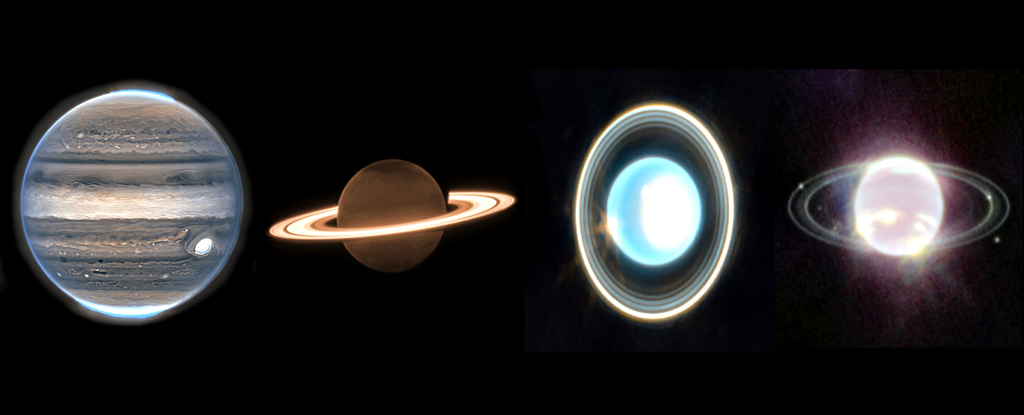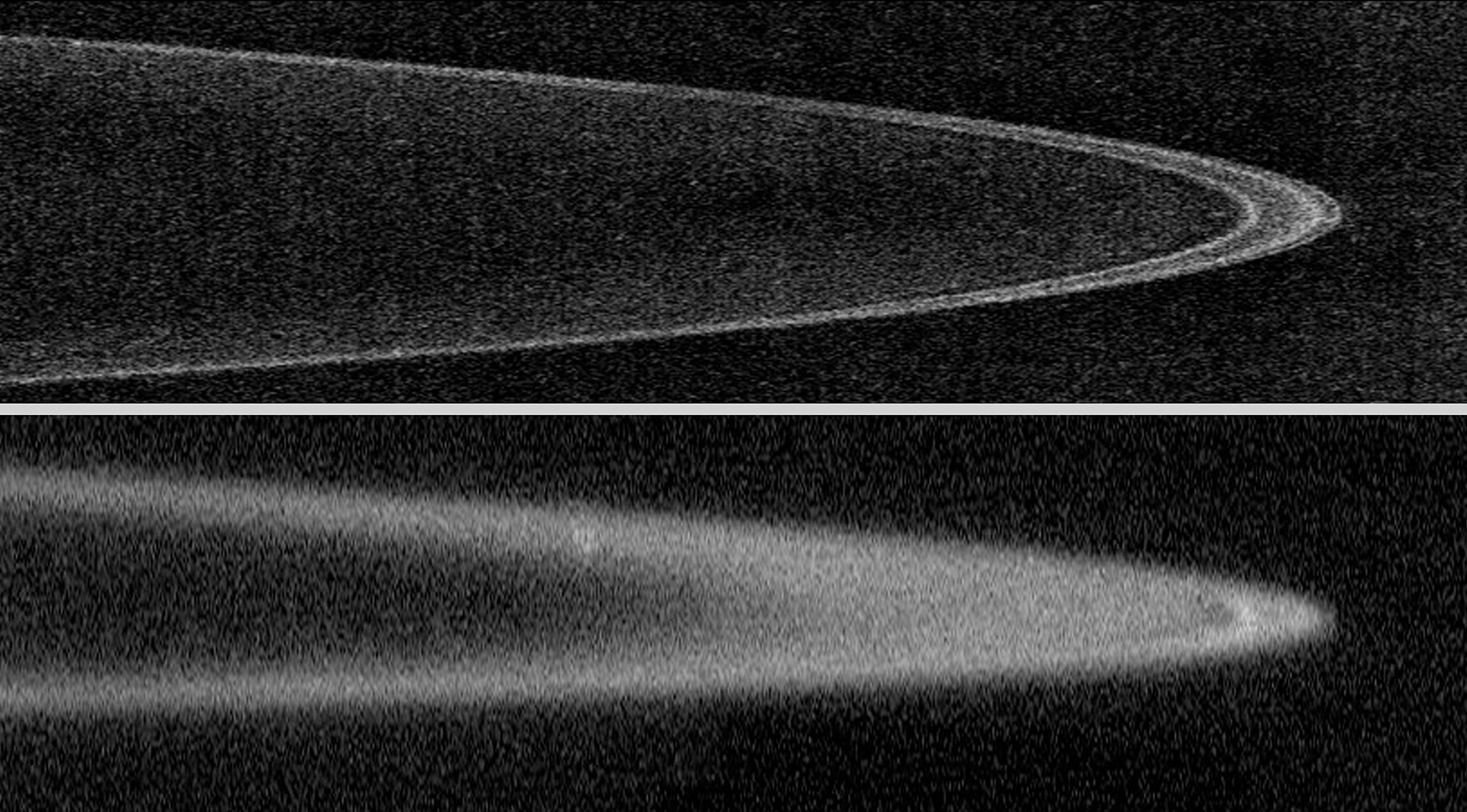Page 1 of 1
APOD: Ringed Ice Giant Neptune (2024 Sep 06)
Posted: Fri Sep 06, 2024 4:05 am
by APOD Robot
 Ringed Ice Giant Neptune
Explanation: Ringed ice giant Neptune
Ringed Ice Giant Neptune
Explanation: Ringed ice giant Neptune lies near the center of this sharp near-infrared image from the
James Webb Space Telescope. The dim and distant world is the
farthest planet from the Sun, about 30 times farther away than planet Earth. But in the stunning Webb view, the planet's dark and ghostly appearance is due to atmospheric methane that absorbs infrared light. High altitude clouds that reach above most of Neptune's absorbing methane easily stand out in the image though. Coated with frozen nitrogen, Neptune's largest moon Triton is brighter than Neptune in reflected sunlight, seen at the upper left sporting the Webb telescope's characteristic
diffraction spikes. Including Triton, seven of Neptune's 14 known moons can be
identified in the field of view.
Neptune's faint rings are striking in this space-based
planetary portrait. Details of the complex ring system are seen here for the first time since Neptune was visited by the
Voyager 2 spacecraft in August 1989.
Re: APOD: Ringed Ice Giant Neptune (2024 Sep 06)
Posted: Fri Sep 06, 2024 3:21 pm
by AVAO
JWST Has Now Captured All 4 Giant Planets:
Re: APOD: Ringed Ice Giant Neptune (2024 Sep 06)
Posted: Fri Sep 06, 2024 3:53 pm
by johnnydeep
So, Neptune's atmospheric methane both absorbs infrared (getting warmer I suppose), and then also emits infrared that is visible to JWST here?
Or is it only the "High altitude clouds that reach above most of Neptune's absorbing methane" that we are seeing here? (And that also must be emitting IR visible to JWST?)
Re: APOD: Ringed Ice Giant Neptune (2024 Sep 06)
Posted: Sat Sep 07, 2024 4:31 am
by AVAO
johnnydeep wrote: ↑Fri Sep 06, 2024 3:53 pm
So, Neptune's atmospheric methane both absorbs infrared (getting warmer I suppose), and then also emits infrared that is visible to JWST here?
Or is it only the "High altitude clouds that reach above most of Neptune's absorbing methane" that we are seeing here? (And that also must be emitting IR visible to JWST?)
The question is good. I would guess the following.
Neptune has high clouds made of methane ice. Methane ice is very good at reflecting infrared light. In contrast, methane absorbs visible light in the blue range, making the planet appear blue to our eyes.
Even more distant gas planets like Neptune emit small amounts of heat, and this heat radiation is in the infrared range. The James Webb telescope is specifically designed and very sensitive to detecting this infrared radiation. The warmer an object is, the brighter it appears in infrared light.
Higher clouds and rings are brighter because they are made of smaller ice crystals, which are very efficient at scattering infrared radiation. This means that much of the infrared light that hits the clouds is deflected in all directions, including back to the telescope. This leads to additional, increased brightness of the higher clouds and rings.
But that would also mean that clouds and ring fragments facing away from the sun would appear less bright or almost invisible than those that are illuminated by the sun...
Re: APOD: Ringed Ice Giant Neptune (2024 Sep 06)
Posted: Sat Sep 07, 2024 4:40 am
by Chris Peterson
AVAO wrote: ↑Sat Sep 07, 2024 4:31 am
johnnydeep wrote: ↑Fri Sep 06, 2024 3:53 pm
So, Neptune's atmospheric methane both absorbs infrared (getting warmer I suppose), and then also emits infrared that is visible to JWST here?
Or is it only the "High altitude clouds that reach above most of Neptune's absorbing methane" that we are seeing here? (And that also must be emitting IR visible to JWST?)
The question is good. I would guess the following.
Neptune has high clouds made of methane ice. Methane ice is very good at reflecting infrared light. In contrast, methane absorbs visible light in the blue range, making the planet appear blue to our eyes.
Even more distant gas planets like Neptune emit small amounts of heat, and this heat radiation is in the infrared range. The James Webb telescope is specifically designed and very sensitive to detecting this infrared radiation. The warmer an object is, the brighter it appears in infrared light.
Higher clouds and rings are brighter because they are made of smaller ice crystals, which are very efficient at scattering infrared radiation. This means that much of the infrared light that hits the clouds is deflected in all directions, including back to the telescope. This leads to additional, increased brightness of the higher clouds and rings.
But that would also mean that clouds and ring fragments facing away from the sun would appear less bright than those that are illuminated by the sun...
Hmm. Some confusion. If the atmospheric methane absorbed blue, the planet would appear more red or yellowish.
We need to be careful in discussing "infrared". NIRCam is sensitive from 0.6 um (red) to 5 um (mid-IR). The Sun doesn't produce a lot of IR, and most of what it does is near-IR, from about 0.7 um to 1.5 um. Presumably the planet is absorbing some mix of visible and near-IR and re-radiating it as thermal IR, at least several microns wavelength: mid- to far-IR.
Re: APOD: Ringed Ice Giant Neptune (2024 Sep 06)
Posted: Sat Sep 07, 2024 5:29 am
by Ann
johnnydeep wrote: ↑Fri Sep 06, 2024 3:53 pm
So, Neptune's atmospheric methane both absorbs infrared (getting warmer I suppose), and then also emits infrared that is visible to JWST here?
Or is it only the "High altitude clouds that reach above most of Neptune's absorbing methane" that we are seeing here? (And that also must be emitting IR visible to JWST?)
Neptune's atmosphere absorbs infrared light, thereby getting fainter at several infrared wavelengths:
But in the stunning Webb view, the planet's dark and ghostly appearance is due to atmospheric methane that absorbs infrared light. High altitude clouds that reach above most of Neptune's absorbing methane easily stand out in the image though.
So indeed, the high altitude clouds that look white in the JWST image probably can't contain (much, or any) atmospheric methane, or else they would be as faint as the rest of Neptune's atmosphere at the infrared wavelengths detected by JWST.
Britannica wrote:
Neptune is more than 50 percent farther from the Sun than is Uranus and so receives less than half the sunlight of the latter. Yet the effective temperatures of these two giant planets are nearly equal. Uranus and Neptune each reflect—and hence also must absorb—about the same proportion of the sunlight that reaches them. As a result of processes not fully understood,
Neptune emits more than twice the energy that it receives from the Sun. The added energy is generated in Neptune’s interior. Uranus, by contrast, has little energy escaping from its interior.
NASA has admitted that it fooled us with the cornflower-blue pictures of Neptune that were shown to the public after the Voyager 2 flyby. Neptune and Uranus are much the same pale cyan hue, and the processes that cause this color - atmospheric methane that absorbs infrared light - are much the same. But Neptune, unlike Uranus, produces appreciable amounts of its own heat. Don't ask me why, because Britannica doesn't know! Maybe Wikipedia does?
What I don't understand is why JWST makes Uranus look at least partly bluish-cyan and Neptune look "ghostly grayish white".
Also note that while we can see the rings of Uranus, Neptune and of course Saturn in the JWST images, the rings of Jupiter are not visible.
Wikipedia wrote: The Jovian ring system is faint and consists mainly of dust. It has four main components: a thick inner torus of particles known as the "halo ring"; a relatively bright, exceptionally thin "main ring"; and two wide, thick and faint outer "gossamer rings", named for the moons of whose material they are composed: Amalthea and Thebe.
The main and halo rings consist of dust ejected from the moons Metis, Adrastea and perhaps smaller, unobserved bodies as the result of high-velocity impacts.
Another oddity of the JWST images of the outer planets is that the rings of Saturn are very bright, but the disk of Saturn is exceptionally dark. Can anyone tell me why?
Ann
Re: APOD: Ringed Ice Giant Neptune (2024 Sep 06)
Posted: Sat Sep 07, 2024 12:59 pm
by johnnydeep
Thanks, guys (AVAO, Chris and Ann).
Re: APOD: Ringed Ice Giant Neptune (2024 Sep 06)
Posted: Sat Sep 07, 2024 1:11 pm
by Chris Peterson
Ann wrote: ↑Sat Sep 07, 2024 5:29 am
Neptune and Uranus are much the same pale cyan hue, and the processes that cause this color - atmospheric methane that absorbs infrared light - are much the same.
Absorbing IR cannot make anything look blue. That requires absorbing longer
visible wavelengths, like red and yellow.
We are seeing all of the JWST images in false color, of course, so what we see is very dependent on the processing.
Re: APOD: Ringed Ice Giant Neptune (2024 Sep 06)
Posted: Sat Sep 07, 2024 1:47 pm
by Ann
Chris Peterson wrote: ↑Sat Sep 07, 2024 1:11 pm
Ann wrote: ↑Sat Sep 07, 2024 5:29 am
Neptune and Uranus are much the same pale cyan hue, and the processes that cause this color - atmospheric methane that absorbs infrared light - are much the same.
Absorbing IR cannot make anything look blue. That requires absorbing longer visible wavelengths, like red and yellow.
We are seeing all of the JWST images in false color, of course, so what we see is very dependent on the processing.
That makes perfect sense, Chris, yet the idea that Neptune and Uranus get their pale cyan color from infrared-absorbing methane in their atmospheres is the explanation that we've been given. I've read it several times.
Perhaps they mean that the methane in the atmosphere of Neptune also absorbs some visible red light.
Anyway, and off topic: I vividly remember reading that some cooling white dwarfs, instead of becoming gradually redder, at some stage of their cooling become bluer instead. I even think I've seen the headline:
Cooling white dwarfs become blue again (or maybe:
White dwarfs get the blues.
But, alas! These cooling red dwarfs aren't get even a tad bluer. Instead, they are getting redder, because at a certain stage of their cooling, some of their infrared wavelengths get shifted to visible red light instead! So, by becoming redder, these white dwarfs were becoming bluer!
I hate that sort of confusion!!!
Ann
 Ringed Ice Giant Neptune
Ringed Ice Giant Neptune

